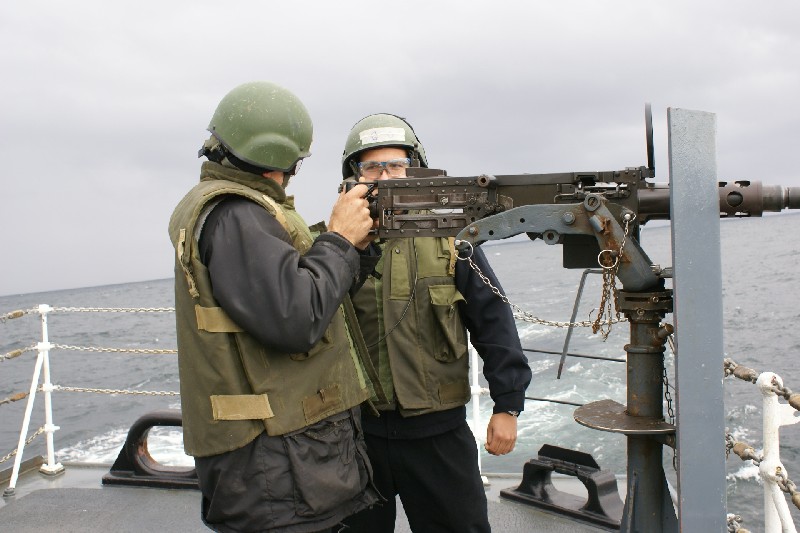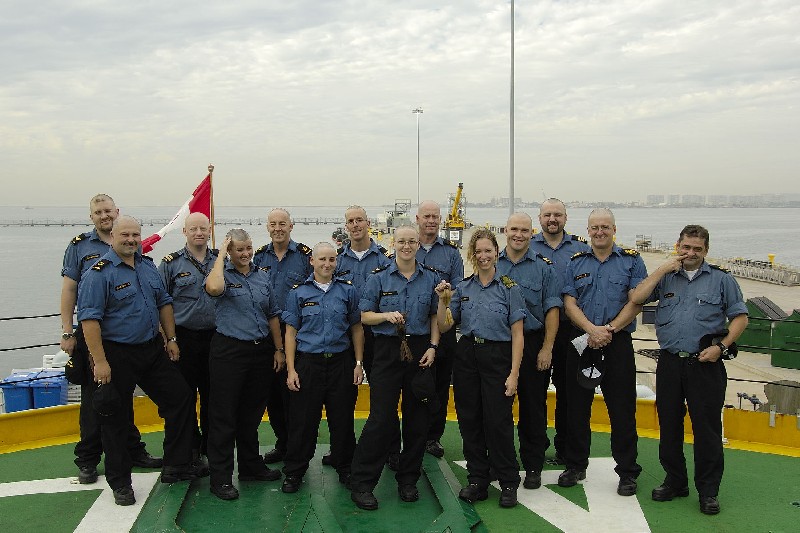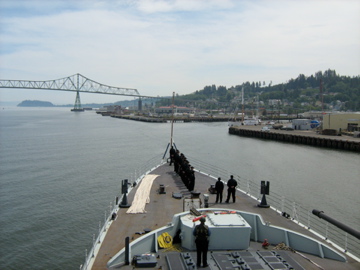HMCS Algonquin
HMCS ALGONQUIN (DDG 283) is an area air defence destroyer. Its advanced communications capability and extra accommodations make it an ideal command and control platform. Built in the early 1970s, in the early 1990s it was extensively converted and refitted with sophisticated anti-air weapons systems, an improved propulsion plant, and advanced weapons and communications systems. Like Canada's newer Halifax-class Canadian Patrol Frigate, ALGONQUIN is equipped with one of the world's most advanced integrated combat control systems. In peacetime, ALGONQUIN can employ its high-tech systems for a variety of important missions, from search and rescue to fisheries and sovereignty patrols. ALGONQUIN's homeport is Esquimalt, British Columbia, on Vancouver Island.
The name ALGONQUIN means "At the place of spearing fish and eels" . Its name was connected to a First Nations People who ranged throughout a vast territory from Georgian Bay in the West, to the St. Maurice River in the East and who made their living by hunting and fishing. The Algonquin people provided an honourable heritage for the ships which were to bear the name of their tribe.

ALGONQUIN’s Helicopters
ALGONQUIN can embark two twin engine CH 124 Sea King gas turbine medium range helicopters. These aircraft have been extensively modified to carry out their role in anti-submarine warfare, operating as an integral extension of the ship’s weaponry. The Sea King is also used to identify vessels and build awareness of the maritime environment.
The Sea King helicopter’s crew consists of two pilots, a tactical coordinator (TACCO) and an airborne electronic systems operator (AESOP). The CH 124A Sea King is equipped with variable depth sonar, radar for surface search and is instrumented for all weather missions. The CH 124B aircraft is fitted with sonobouy processing equipment and is able to passively detect and track submarines. Both aircraft are capable of carrying two MK 46 anti-submarine torpedoes.
Air operations in rough seas are possible with the aid of the Canadian designed “Beartrap” or Helicopter Hauldown Rapid Securing Device.
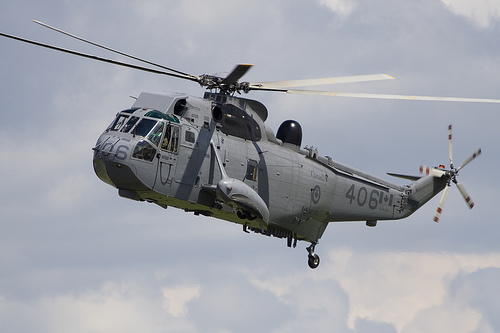
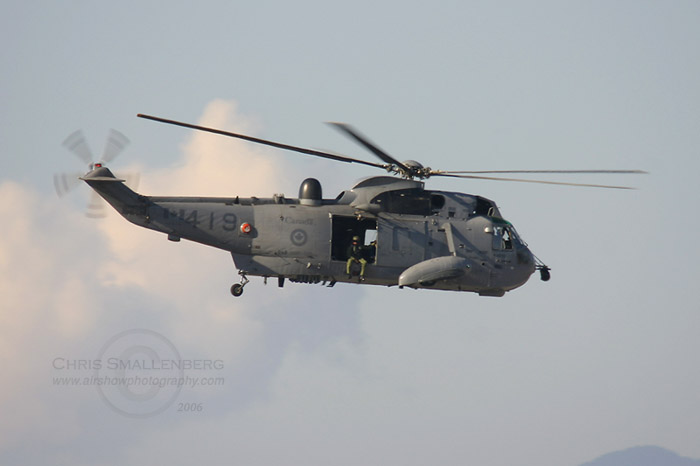
HMCS ALGONQUIN
SHIP'S BADGE AND MOTTO
SHIP'S MOTTO: A Coup Sur (With Sure Stroke)
SHIP'S COLOURS: Gold and Azure Blue
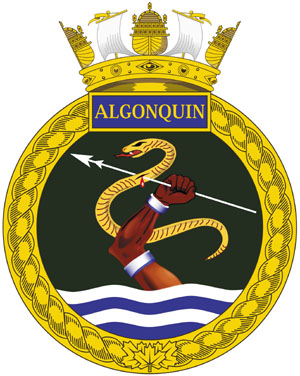
Blazon: A base of silver and blue waves from which extends a warrior's arm decorated with a silver arm and wrist band, holding a fish-spear transfixing a golden eel.
Significance: This was one of the best badge designs produced during the war before ship's badges were issued officially. Of such excellence of design and appropriateness in suggesting this destroyer's activities in anti-submarine warfare, it has been accepted as the official badge.
The Proud Heritage of HMCS Algonquin
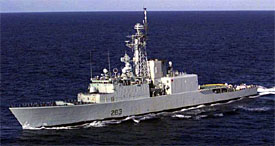
HMCS ALGONQUIN is one of four Tribal class destroyers built for the Canadian Navy in the early 1970s. The name “Algonquin” means “At the place of spearing fish and eels.” This name was connected to a tribe of First Nations people who ranged throughout a vast territory from Georgian Bay in the West, to the St-Maurice River in the East, and who made their living by hunting and fishing. The Algonquin people provided an honourable heritage for the ships, which were to bear the name of their tribe.
Todays HMCS Algonquin
Commissioned 3 November 1973
The current HMCS ALGONQUIN is the second ship in the Canadian Navy to bear this proud name. The first HMCS ALGONQUIN was launched in September 1943 as the British “V” Class Fleet Destroyer, HMS VALENTINE. After negotiations between the British and the Canadian government, HMS VALENTINE was obtained by the latter and commissioned HMCS ALGONQUIN in February, 1944. For more than twenty years, HMCS ALGONQUIN was a proud and worthy fleet asset. Finally in 1971 she was paid off and disposed of through Crown Assets. Over the years she received numerous battle honours which are worn with pride on the new ALGONQUIN.
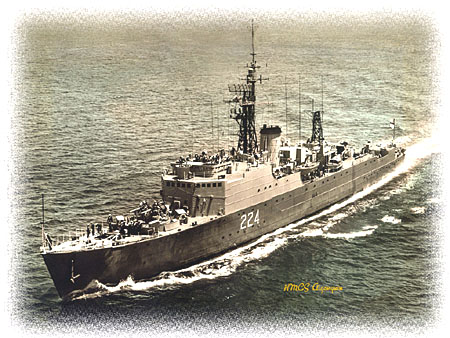
The second HMCS ALGONQUIN was built by Davie Shipbuilding Ltd. In Lauzon, Quebec and was commissioned on the 3rd of November 1973, becoming the fourth tribal class destroyer to be delivered to the fleet. ALGONQUIN was originally designed for Anti-Submarine Warfare (ASW), however, all of the Tribal class destroyers have been transformed into modern Task Group Command and Area Air Defence ships while retaining their significant ASW capability. This change was completed through the Tribal Update and Modernization Project (TRUMP). With an extended life, new electrical, propulsion and combat systems, HMCS ALGONQUIN has become one of the most capable vessels of its size in the world
ALGONQUIN has participated in a wide variety of operations ranging from search and rescue to sovereignty patrols and has participated in a number of multi-national training exercises. On March 23, 2002, ALGONQUIN was deployed on OP APOLLO (Canada’s contribution to the campaign against terrorism), as the Flag Ship for the Canadian Task Group in the Gulf of Oman. During the deployment ALGONQUIN coordinated the efforts of the Canadian Task Group and patrolled the Gulf of Oman conducting Leadership Interdiction Operations. ALGONQUIN returned on October 14, 2002, after covering thousands of nautical miles and spending nearly 7 months at sea.
BATTLE HONOURS WORN WITH PRIDE WITH THE PRESENT HMCS ALGONQUIN
* Norway 1944
* Normandy 1944
* Artic 1944-1945
Characteristics
* Type: IROQUOIS Class Destroyer
* Displacement: 5,146 tonnes
* Length: 130 metres
* Beam: 15.2 metres
* Draught: 7.6 metres
* Propulsion: 2 Pratt & Whitney FT-A4s capable of producing 25, 000 Shaft Horsepower; and 2 Allison 570KF cruise engines each capable of producing 6, 440 Shaft Horsepower
* Speed: Greater than 27 knots
* Aircraft: Capable of carrying two CH-124 Sea King Helicopters
* Complement: 295 Officers and Crew
* Armament/Guns: 76mm Oto Melara Super-Rapid Gun; Vulcan Phalanx 20mm Close in Weapons System (CIWS); 29 Vertical Launch Standard Missiles; 2 triple torpedo tudes to launch MK46 torpedoes
* Commissioned: 3 November 1973
* Modernized: December 1990
